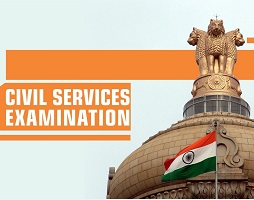There is a common UPSC syllabus pattern for services such as:
• the Indian Administrative Service,
• Indian Foreign Service,
• Indian Police Service,
• Indian Revenue Service (Customs and Central Excise) to name a few.
However, different stages of the IAS exam have a different syllabus.
The UPSC Prelims syllabus focuses on general and societal awareness which is tested by objective-type (MCQ) questions.
The UPSC Mains syllabus is much more comprehensive as this stage comprises nine theory papers.
The Civil services exam is conducted in three phases:
Phase 1: Civil Services (Preliminary) Examination (Objective Type)
Phase 2: Civil Services (Mains) Examination (Descriptive Type)
Phase 3: Personal Interview (Personality Test)
Phase 1: UPSC Prelims Exam
The UPSC Civil Services Prelims Examination is composed of two components:
1) General Studies
| Paper | Subjects | Total Marks | Duration |
| I | General Studies (GS) | 200 | 2 hours (9:30 AM to 11:30 AM) |
| II | CSAT | 200 | 2 hours (2:30 PM to 4:30 PM) |
Civil Services Aptitude Test (CSAT)
• Broadly, the UPSC Civil Services (Preliminary) Examination consists of two papers of objective type, each of 200 marks (hence totalling 400 marks) and of two hours duration. To qualify for the Civil Services Mains, a candidate must attempt both the papers.
• Further, the UPSC General Studies (GS) paper consists of 100 questions, while the CSAT paper consists of 80 questions. Both papers have negative marks for wrong answers marked to the tune of 1/3rd of the total marks assigned to that question.
• To further illustrate this, each correctly answered GS question will be awarded 2 marks. So, 0.66 marks would be deducted from the total for every question that is wrongly marked.
• Similarly, in the CSAT paper, since we have 80 questions for 200 marks, correctly answered CSAT questions would attract 2.5 marks each, while every wrongly marked question would attract a penalty of 0.833 for each such wrong answer, which will be deducted from the total.
• Questions that are not attempted will not attract any negative marks.
The two papers of the IAS prelims are discussed in detail below:
1. General Studies (Generally conducted between 9:30 AM and 11:30 AM)
The General Studies test is the first paper of the preliminary examination.
This test is intended to test the general awareness of a candidate in a wide range of subjects that include Indian Polity, Geography, History, Indian Economy, Science and Technology, Environment and Ecology, International Relations and associated UPSC current affairs.
2. Civil Services Aptitude Test (CSAT)(Generally conducted between 2:30 PM and 04:30 PM)
• This UPSC Prelims syllabus for CSAT intends to assess the aptitude of the candidate in solving ‘Reasoning and Analytical’ questions, apart from ‘Reading Comprehension and the occasionally asked ‘Decision Making’ questions.
• The ‘Decision Making’ based questions are generally exempt from negative marks.
• The preliminary examination is only meant for screening a candidate for the subsequent stages of the exam.
• The marks obtained in the Prelims will not be added up while arriving at the final rank list.
Phase 2: UPSC Mains Exam (1750 Marks)
• The Mains examination constitutes the 2nd phase of the Civil Services Examination. Only after successfully qualifying in the prelims exam would allow the candidates to write the IAS Mains.
• The Mains exam tests the candidate’s academic talent in depth and his/her ability to present his/her understanding according to the requirements of the question in a time-bound manner.
• The UPSC Mains exam consists of 9 papers, out of which two are qualifying papers of 300 marks each.
• The two qualifying papers are:
• Any Indian Language Paper
• English Language Paper
• The papers on Essay, General Studies and Optional Subject of only such candidates who attain 25% marks in both the language papers as a minimum qualifying standard in these qualifying papers, will be taken cognizance of, for evaluation.
• In case a candidate does not qualify in these language papers, then the marks obtained by such candidates will not be considered or counted.
Structure of the language papers:
The types of questions asked are –
UPSC Mains Syllabus
| Paper | Subject | Marks |
| Paper – I | Essay (can be written in the medium of the candidate’s choice) | 250 |
| Paper – II | General Studies – I (Indian Heritage & Culture, History & Geography of the World & Society) | 250 |
| Paper – III | General Studies – II (Governance, Constitution, Polity, Social Justice & International Relations) | 250 |
| Paper – IV | General Studies – III (Technology, Economic Development, Biodiversity, Security & Disaster Management) | 250 |
| Paper – V | General Studies – IV (Ethics, Integrity & Aptitude) | 250 |
| Paper – VI | Optional Subject – Paper I | 250 |
| Paper – VII | Optional Subject – Paper II | 250 |
Civil Services Exam Syllabus for IAS Mains Optional Subjects:
UPSC Syllabus for Optional Subjects
| Agriculture | Zoology |
| Animal Husbandry & Veterinary Science | Assamese (Literature) |
| Anthropology | Bengali (Literature) |
| Botany | Bodo (Literature) |
| Chemistry | Dogri (Literature) |
| Civil Engineering | Gujarati (Literature) |
| Commerce & Accountancy | Hindi (Literature) |
| Economics | Kannada (Literature) |
| Electrical Engineering | Kashmiri (Literature) |
| Geography | Konkani (Literature) |
| Geology | Maithili (Literature) |
| History | Malayalam (Literature) |
| Law | Manipuri (Literature) |
| Management | Marathi (Literature) |
| Mathematics | Nepali (Literature) |
| Mechanical Engineering | Odia (Literature) |
| Medical Science | Punjabi (Literature) |
| Philosophy | Sanskrit (Literature) |
| Physics | Santhali (Literature) |
| Political Science & International Relations | Sindhi (Literature) |
| Psychology | Tamil (Literature) |
| Public Administration | Telugu (Literature) |
| Sociology | English (Literature) |
| Statistics | Urdu (Literature) |
Phase 3: IAS Interview/UPSC Personality Test (275 Marks)
• Candidates who qualify for the UPSC Mains Exam will be called for the ‘Personality Test/Interview’.
• These candidates will be interviewed by a Board appointed by the UPSC.
• The objective of the interview is to assess the personal suitability of the candidate for a career in civil services by a board of competent and unbiased observers.
• The interview is more of a purposive conversation intended to explore the mental qualities and analytical ability of the candidate.
• The Interview test will be 275 marks and the total marks for the written examination is 1750.
• This sums up to a Grand Total of 2025 Marks, based on which the final merit list will be prepared.
Educational qualification
All candidates must have as a minimum one of the following educational qualifications:
• A degree from a Central, State or a Deemed university.
• A degree received through correspondence or distance education.
• A degree from an open university.
• A qualification recognized by the Government of India as being equivalent to one of the above.
• The following candidates are also eligible but must submit proof of their eligibility from a competent authority at their institute /university at the time of the main examination, failing which they will not be allowed to attend the exam.
• Candidates who have appeared in an examination the passing of which would render them educationally qualified enough to satisfy one of the above points.
• Candidates who have passed the final exam of the MBBS degree but have not yet completed an internship.
• Candidates who have passed the final exam of ICAI, ICSI and ICWAI.
• A degree from a private university.
• A degree from any foreign university recognized by the Association of Indian Universities.
Age
The candidate must have attained the age of 21 years and must not have attained the age of 32 years (for the General category candidate) on 1 August of the year of examination. Prescribed age limits vary with respect to caste reservations.
• For Other Backward Castes (OBC) the upper age limit is 35 years.
• For Scheduled Castes (SC) and Scheduled Tribes (ST), the limit is 37 years.
• For Defense Services Personnel disabled in operations during hostilities, the limit is 40 years.
• For Candidates belonging to ex-servicemen including Commissioned
• officers and ECOs/SSCOs who have rendered military services for at least five years as of 1 August, of the year and have been released
• on completion of assignment (including those whose assignment is due to be completed within one year from 1 August of the year otherwise than by way of dismissal or discharge
• on account of misconduct or inefficiency or on account of physical disability attributable to Military Service or
• on invalidation or
• Relaxation of up to a maximum of five years will be given in the case of ECOs/SSCOs who have completed an initial period of assignment of five years of Military Service as on 1 August of the year and whose assignment has been extended beyond five years and in whose case the Ministry of Defense issues a certificate that they can apply for civil employment and that they will be released on three months' notice on selection from the date of receipt of offer of appointment, the limit is 32 years.
• For ECOs/SSCOs who have completed an initial period of assignment of five years of Military Service, the limit is 32 years.
• For PWD candidates, the limit is 37 years.
• For Domiciles of Jammu and Kashmir from 1 January 1980 to 31 December 1989, the limit is 32 years.
• For the Economically Weaker Section (EWS) category, the standard age limits apply.
Number of attempts
The number of times a candidate can appear for the exam are given below.
• General category candidates – 6
• OBC category candidates – 9
• SC/ST candidates – unlimited attempts till 37 years of age.





Contrary to popular belief, Lorem Ipsum is not simply random text. It has roots in a piece of classical Latin literature College in Virginia ?
It is a long established fact that a reader will be distracted by the readable content of a page when looking at its layout. The point of using Lorem Ipsum.